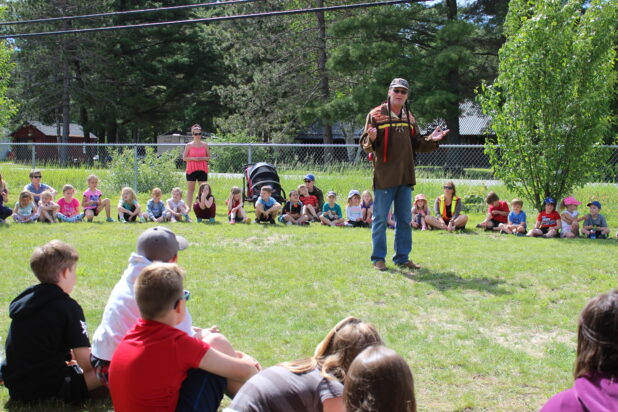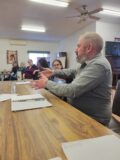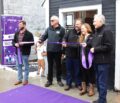Headline News
Chief Stephen Hunter: A life in honour of future generations
July 12, 2022

By Nate Smelle
The community is mourning the loss of Kijicho Manito Madaouskarini Algonquin Chief Stephen Hunter. On Monday, June 27, Hunter passed away from lung cancer at the age of 53, while surrounded by his family at Quinte Health Care North Hastings Hospital in Bancroft.
A Sacred Fire was lit for Hunter outside his home in Bancroft, where he lived with his spouse Jenny. As it continued to burn over the course of the next four days, the late Chief’s family and friends gathered around the Sacred Fire to offer prayers, and honour his life and legacy.
After the Sacred Fire had burned out, Hunter’s sister Lynn Hunter-Murphy, and brother Rob Hunter took time to speak with The Bancroft Times, and share what made their brother such an effective leader and powerful advocate for the Algonquin people.
Since 2017, Hunter has served as the Algonquin Negotiation Representative and Chief of the Kijicho Manito Madaouskarini Algonquin First Nation. Through his work in these roles, he consistently and successfully brought Indigenous and non-Indigenous people together to learn about the history and culture of the people who have inhabited this land since time immemorial.
Whether building a traditional Algonquin birch bark canoe for charity with his friend and fellow canoe builder Chuck Commanda of the Kitigan Zibi Anishnabeg in Quebec, representing the interests of the Kijicho Manito Madaouskarini Algonquin First Nation during land claim negotiations, or, educating local students about Ginowaydaganuc – the interconnectedness of all things on Earth – Hunter always approached life with a “growth mindset,” explained his sister Lynn.
“He was very inquisitive about things, so he wasn’t quick to judge, because he wanted to understand,” she said.
Looking back on how instrumental this approach was for Hunter as a leader, Lynn said he would use his evolving understanding to better serve the community, and educate people about Algonquin culture. As a passionate community builder, she said it was of utmost importance to him to embrace inclusivity through his work.
“His approach to the work that he did in the community was very inclusive,” said Lynn. “There wasn’t a delineation necessarily between Indigenous and non-Indigenous people… He wanted to be a leader and a resource to support the collaboration and connectivity between Indigenous and non-Indigenous people together.”
Acknowledging that Hunter came from a long line of gifted teachers and leaders, Lynn said her brother had a unique ability as a storyteller to inspire others since he was a child.
“He was a natural born teacher, who came from a long line of teachers,” said Lynn.
“My great grandmother, grandmother, aunt, and mother all taught public school; and I teach life skills and financial literacy, customer service training and leadership skills to adults in the credit union system. Stephen was teaching everybody.”
Noting that he didn’t want to spend a lot of time looking backwards, Lynn said Hunter instead chose to focus his attention on looking forward towards the future. Even in his final days, Lynn said Hunter continued working to help future generations heal. Recognizing that the hospital in Bancroft did not have a protocol in place allowing Indigenous people to use traditional medicines and healing practices, she said Hunter inspired the local hospital to merge Indigenous culture and medicine with the conventional “western” model of health-care.
“Prior to Stephen being admitted to the hospital, the hospital in Bancroft had no point of reference regarding how Indigenous culture could be integrated into western culture when it came to health-care,” Lynn explained. “Folks wanted to do some smudging, they wanted to hang spruce in the room, and this had never happened in all the years that the Bancroft hospital has been here. So even in his final days, Stephen created a legacy because he asked for these things to happen, and after 24 hours the health authority said ‘absolutely.’ So now there’s a precedent.”
Lynn continued:
“There was sage attached to the wall in the entry way; and the reason for that is to ward off any bad thoughts, any negative feelings that might be coming into the room. There was smudging that went on in the room, and there was actually drumming that went on in the room and outside in the courtyard on three separate occasions in Stephen’s last week.”
Working closely with his brother over the past five years, Rob gained insight into Hunter’s inspirational style of leadership, and vision of the future. Through working together, he said his brother convinced him “that there was something super valuable that I wasn’t really in touch with … something bigger than myself that was worth preserving.”
At the core of his brother’s work, Rob said there was a passion for community building through healing the injustices of the past. Inspiring this passion, he said, was Hunter’s deep desire to restore the honour of the Algonquin people.
“He didn’t dwell on the past at all,” explained Rob. “He was not just going to get into the grievance business. He was interested in: restoring the honour of the Algonquin people locally and in the larger [community]; and, restoring the honour of the government of the Algonquin… He was all about healing the injustices, and helping to bring them to some sort of reasonable conclusion. That healing was about the future. It was not about going back and unearthing every little thing, and inspecting it. He realized that we have to make this right as a people, moving forward.”
Reminiscing on the time they spent with their brother exploring the traditional lands of the Kijicho Manito Madaouskarini Algonquin people as children and teenagers, both Rob and Lynn said Hunter always had a deep connection with the Earth. Acknowledging how Hunter would incorporate this respect for nature into his work as Chief and Algonquin Negotiation Representative, Rob explained how his brother would lead others by setting a good example of how to be a responsible steward of the land, air, water, and web of biodiversity that gives us life.
“My brother had this place in his body,” Rob said. “He tried to map every inch of it in his head. It was our local universe, and it was vast and big. He wanted to know where all the rivers were, all the lakes, all the places where you could put a canoe in and where you couldn’t, every good ‘canoe-bark tree’ was. He was cataloguing that stuff in his brain, so we can take better care of it.”
Hunter’s cousin Sherry Crawford – the Algonquin artist known as White Bear Standing – describes Hunter as one of the most passionate men she has ever known. She said his heart was so big that his eyes would often well up when he would speak about his community, and how much he loved his role as Chief. Not only did Hunter take it upon himself to walk the lands he loved as a part of himself, Crawford said he always did his best to “walk the talk.”
“He was my cousin, my friend, my mentor and a good man,” Crawford said. “I’m going to miss him and his open arms, warm hugs and the way he would always tell me he loved me. He was not afraid to share his love with everyone and it was genuine. He was eager to share our culture and history with anyone who was interested.”
Recalling one of her favourite memories with her cousin, Crawford told The Bancroft Times about the day he took her out into the backcountry, to walk some of the sacred lands of the Kijicho Manito Madaouskarini Algonquin First Nation.
“We were four-wheeling down back roads in his pickup truck; me holding on for dear life as we proceeded to go down roads that were only half there, up over rocks and roots … a real backwoods experience,” said Crawford. “I’ll never forget that special day we spent together. There is a [space] left in our hearts and our community that is going to take some big shoes and a big heart to fill.”
Hunter’s family and loved ones recently held a private service to scatter his ashes in a place that was sacred to the late Chief. The family said a larger celebration of Hunter’s life will take place at a later date.


















